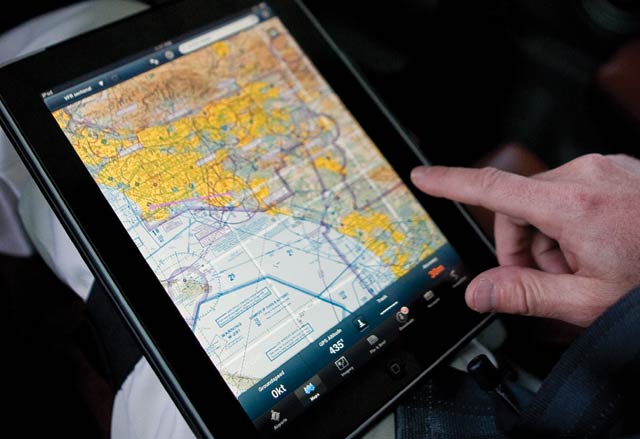
Is the iPad a legal replacement for paper charts?
“The answer is yes! … Asterisk,” said Sporty’s Vice President John Zimmerman in the seminar “iPad 101,” at AOPA Aviation Summit Oct. 11. For normal Part 91 operations, pilots can use the popular tablet in lieu of paper but should use it during an evaluation period first; for those flying Part 121 or Part 135 operations, the answer is probably still “yes,” Zimmerman said, but you may have to fill out some paperwork. Zimmerman offered practical tips for novice iPad users, advising on topics from whether to spend the extra cash for 3G to how to configure it for in-flight use.
Thinking of buying an iPad, or turning yours into a flying tool? Check out these five tips from Zimmerman’s presentation.
- Buy what you’ll use. Which iPad is best for you? The new iPad (commonly referred to as the iPad 3) offers more features than its predecessor, but budget-conscious buyers who aren’t going to use all the bells and whistles may want to consider the iPad 2, Zimmerman noted.
With 16, 32, and 64 GB offerings, pilots can get by with 16 GB, he added, as all the charts in the United States typically add up to no more than 8 GB. But consider that you may download chart updates a couple of days ahead of time, bumping the storage closer to 16 GB. If you use your iPad for nonaviation purposes too, you may want to opt for 32 GB.
Frequent travelers may want 3G data, but others may not need it. The built-in GPS in the 3G devices doesn’t work as well in the air as on the ground, Zimmerman said, and pilots with Wi-Fi-only iPads can buy a more reliable external GPS for around $100.
- Understand the limitations. The iPad reflects light. A pilot starting out with the iPad is bound to experience screen glare. “Does that make it an unusable piece of junk?” Zimmerman said. “No.” A pilot experiencing glare can usually tilt the screen about 20 degrees and the glare is gone, he said. After a couple of flights, one can find a spot to mount or hold the iPad to minimize glare. Anti-glare covers can take the edge off glare, but Zimmerman warned, “Don’t get sold on a miracle cure.”
Apple publishes an operating temperature for the iPad between 32 and 95 degrees Fahrenheit and a max operating altitude of 10,000 feet. Practically, pilots have used the iPad outside those parameters. Zimmerman said the only time he has had the iPad overheat was when he left it in direct sunlight in the glareshield; it shut itself down to prevent damage. Pilots can deal with another limitation, the prospect of GPS interference, by configuring the iPad correctly for flight.
- Think beyond EFBs. Beyond the apps for in-flight use, the iPad offers a platform for test preparation, weight and balance and E6B calculations, logbooks, and storing digital copies of what could be bulky paper publications. “The iPad was practically invented for the FAR/AIM,” Zimmerman said. The app GoodReader allows users to read PDF documents—such as the Pilot’s Handbook of Aeronautical Knowledge or the Instrument Flying Handbook, available free online—as they would an e-reader.
- Try before you buy. Zimmerman discussed a number of full-feature electronic flight bag apps, but stressed that ease of use for the individual is most important. “This is Coke and Pepsi,” he said. “I don’t think there’s a right or wrong answer.” Most apps offer a free 30-day trial, so pilots can test drive an app before buying a subscription, he said: “Don’t buy an app on a feature list.”
- Preflight your iPad. Before you fly, do you make sure you’ve downloaded—not streamed—the latest aviation databases? One common new user error, failing to make sure one’s aviation databases are up to date, can leave a pilot without important information in the air.
Preflight your iPad just as you do your airplane. Zimmerman recommended charging the battery of the iPad, and its wireless accessories, before each flight. (Pilots also might consider a backup power option, as weather and GPS accessories can cut the iPad’s eight- to 10-hour battery life by 30 percent, he said.) Make sure your apps are up to date, and load your favorites and routes. To maximize your battery life, turn the screen brightness lower and turn off Wi-Fi, 3G, or Bluetooth if you don’t need them, Zimmerman said. And don’t leave the iPad on the glareshield.
Pilots also should configure their wireless radios. An iPad with an attached GPS such as Bad Elf should be set to airplane mode, he said. For a GPS connected by Bluetooth, the pilot should turn on airplane mode, and then turn Bluetooth on. For a receiver like Stratus, which uses a Wi-Fi connection, the pilot should turn on airplane mode, and then turn on the Wi-Fi. Pilots using only the internal GPS should turn off airplane mode, and then turn off Wi-Fi, Bluetooth, and cellular data.
Sporty’s offers a newsletter and website to help pilots make the most of their iPads.


